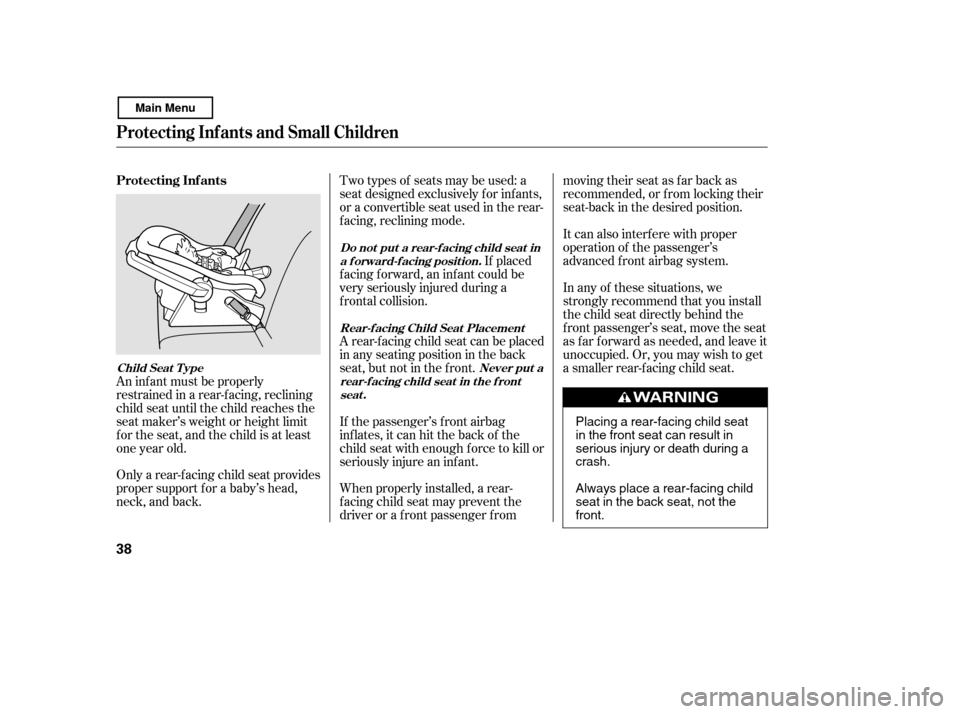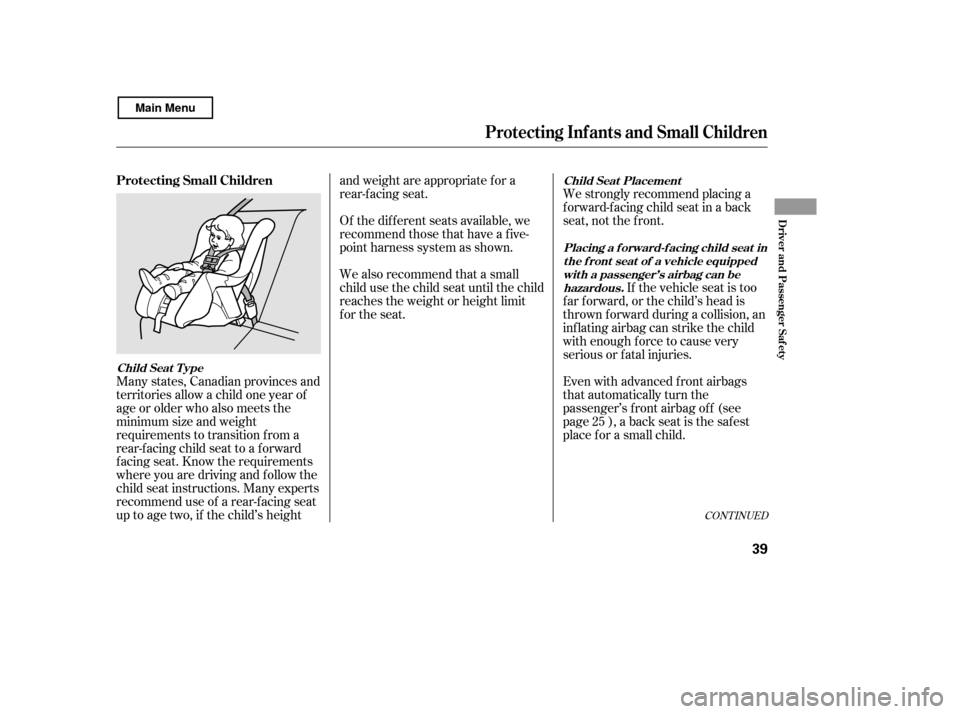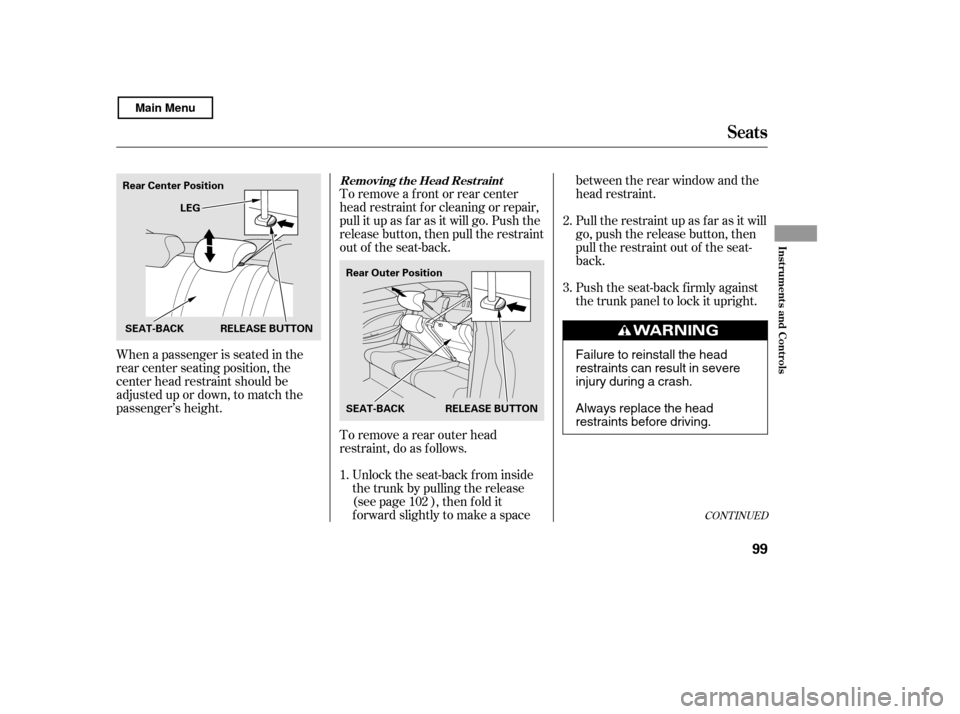Page 42 of 400

An inf ant must be properly
restrained in a rear-f acing, reclining
child seat until the child reaches the
seat maker’s weight or height limit
f or the seat, and the child is at least
one year old.
Only a rear-f acing child seat provides
proper support f or a baby’s head,
neck, and back.Two types of seats may be used: a
seat designed exclusively f or inf ants,
or a convertible seat used in the rear-
f acing, reclining mode.
If placed
f acing f orward, an inf ant could be
very seriously injured during a
f rontal collision.
A rear-f acing child seat can be placed
in any seating position in the back
seat, but not in the f ront.
If the passenger’s f ront airbag
inflates, it can hit the back of the
child seat with enough f orce to kill or
seriously injure an inf ant.
When properly installed, a rear-
f acing child seat may prevent the
driver or a f ront passenger f rom moving their seat as far back as
recommended, or f rom locking their
seat-back in the desired position.
It can also interf ere with proper
operation of the passenger’s
advanced front airbag system.
In any of these situations, we
strongly recommend that you install
the child seat directly behind the
f ront passenger’s seat, move the seat
as far forward as needed, and leave it
unoccupied. Or, you may wish to get
a smaller rear-f acing child seat.
Protecting Inf ants
Child Seat T ype
Do not put a rear-f acing child seat in
a f orward-f acing position.
Never put a
rear-f acing child seat in t he f ront
seat .
Rear-f acing Child Seat Placement
Protecting Inf ants and Small Children
38
Placing a rear-facing child seat
in the front seat can result in
serious injury or death during a
crash.
Always place a rear-facing child
seat in the back seat, not thefront.
Main Menu
Page 43 of 400

Many states, Canadian provinces and
territories allow a child one year of
age or older who also meets the
minimum size and weight
requirements to transition f rom a
rear-facing child seat to a forward
f acing seat. Know the requirements
where you are driving and follow the
child seat instructions. Many experts
recommend use of a rear-f acing seat
up to age two, if the child’s heightand weight are appropriate f or a
rear-f acing seat.
Of the different seats available, we
recommend those that have a f ive-
point harness system as shown.
We also recommend that a small
child use the child seat until the child
reaches the weight or height limit
for the seat.
We strongly recommend placing a
forward-facing child seat in a back
seat, not the f ront.
If the vehicle seat is too
f ar f orward, or the child’s head is
thrown f orward during a collision, an
inf lating airbag can strike the child
with enough force to cause very
serious or f atal injuries.
Even with advanced front airbags
that automatically turn the
passenger’s f ront airbag of f (see
page ), a back seat is the saf est
place f or a small child. 25
CONT INUED
Protecting Inf ants and Small Children
Protecting Small Children
Child Seat T ype Child Seat Placement
Placing a f orward-f acing child seat int he f ront seat of a vehicle equipped
with a passenger’s airbag can behazardous.
Driver and Passenger Saf ety
39
Main Menu
Page 52 of 400
When a child reaches the
recommended weight or height limit
for a forward-facing child seat, the
child should sit in a back seat on a
booster seat and wear the lap/
shoulder belt.
The f ollowing pages give
instructions on how to check proper
seat belt f it, what kind of booster
seat to use if one is needed, and
important precautions f or a child
who must sit in f ront.To determine if a lap/shoulder belt
properly f its a child, have the child
put on the seat belt, then ask
yourself :Does the child sit all the way back
against the seat?
Do the child’s knees bend
comf ortably over the edge of the
seat?
1. 2.
Checking Seat Belt Fit
Protecting L arger Children
48
Allowing a child age 12 or under
to sit in front can result in injury
or death if the passenger’s front
airbag inflates.
If a child must ride in front,
move the vehicle seat as far
back as possible, use a booster
seat if needed, have the child
sit up properly and wear the
seat belt properly.
Main Menu
Page 54 of 400

A child may continue using a booster
seat until the tops of their ears are
even with the top of the vehicle’s or
booster’s seat-back. A child of this
height should be tall enough to use
the lap/shoulder belt without a
booster seat.If the passenger’s f ront airbag
inf lates in a moderate to severe
f rontal collision, the airbag can cause
serious injuries to a child who is
unrestrained, improperly restrained,
sitting too close to the airbag, or out
of position.
A side airbag also poses risks. If any
part of a larger child’s body is in the
path of a deploying side airbag, the
child could receive possibly serious
injuries.Of course, children vary widely. And
while age may be one indicator of
when a child can saf ely ride in f ront,
there are other important f actors you
should consider.
To saf ely ride in f ront, a child must
be able to f ollow the rules, including
sitting properly, and wearing the seat
belt properly throughout a ride.
Physically, a child must be large
enough f or the lap/shoulder belt to
properly f it (see pages and ). If
the seat belt does not f it properly,
with or without the child sitting on a
booster seat, the child should not sit
in f ront.
The National Highway Traffic Safety
Administration and Transport
Canada recommend that all children
age 12 and under be properly
restrained in the back seat.
14 48
When Can a L arger Child Sit in
Front
Physical Size
Maturity
Protecting L arger Children
50
Main Menu
Page 100 of 400
The height of your driver’s seat is
adjustable. To raise the seat bottom,
repeatedly pull up the lever on the
outside of the seat cushion. To lower
the seat, push the lever down
repeatedly.
Make all seat adjustments bef ore
you start driving.To get into the rear seat on the
driver’s side, open the door and pull
up on the seat-back adjustment lever.
The seat-back will tilt f orward to
allow easier entry to the rear seat.
To use the console lid as an armrest,
slide it to one of its three positions.On all models except U.S. DX
Driver’s Seat Height A djustment A rmrest Rear Seat A ccess
Driver’s Side
Seats
96
SEAT-BACK ADJUSTMENT LEVER
Main Menu
Page 102 of 400
See page f or important saf etyinf ormation and a warning aboutimproperly positioning head restraints. 13
Your vehicle is equipped with head
restraints in all seating positions to
help protect you and your
passengers f rom the likelihood of
whiplash and other injuries.
They are most ef f ective when you
adjust them so the center of the back
of the occupant’s head rests against
the center of the restraint.The head restraints adjust f or height.
You need both hands to adjust a
restraint.Donotattempttoadjustit
while driving. To raise it, pull upward.
To lower the restraint, push the
release button sideways, and push
the restraint down.
Head Restraints
A djust ing t he Head Rest raint
Seats
98
FRONT
LEGS SEAT-BACK RELEASE
BUTTON
Main Menu
Page 103 of 400

When a passenger is seated in the
rear center seating position, the
center head restraint should be
adjusted up or down, to match the
passenger’s height.To remove a f ront or rear center
head restraint f or cleaning or repair,
pull it up as f ar as it will go. Push the
release button, then pull the restraint
out of the seat-back.
To remove a rear outer head
restraint, do as f ollows.
Unlock the seat-back from inside
the trunk by pulling the release
(see page ), then f old it
f orward slightly to make a space between the rear window and the
head restraint.
Pull the restraint up as f ar as it will
go, push the release button, then
pull the restraint out of the seat-
back.
Push the seat-back firmly against
the trunk panel to lock it upright.
1. 2. 3.
102
CONT INUED
Removing t he Head Rest raint
Seats
Inst rument s and Cont rols
99
Rear Center Position LEG
SEAT-BACK Rear Outer Position
SEAT-BACK RELEASE BUTTON
RELEASE BUTTON
Failure to reinstall the head
restraints can result in severe
injury during a crash.
Always replace the head
restraints before driving.
Main Menu
Page 104 of 400

This reduces the distance between
the restraint and the occupant’s head.
It also helps protect the occupants
against the likelihood of whiplash
and injuries to the neck and upper
spine.
Af ter a collision, the activated
restraint should return to its normal
position.
If the restraints do not return to their
normal position, or in the event of a
severe collision, have the vehicle
inspected by a Honda dealer.
The driver’s and f ront passenger’s
seats have active head restraints. If
the vehicle is struck severely f rom
the rear, the occupant properly
secured with the seat belt will be
pushed against the seat-back and the
head restraint will automatically
move forward.
When reinstalling a head restraint,
put the legs back in place. Then
adjust it to the appropriate height
while pressing the release button.
Make sure the head restraint locks
in position when you reinstall it.
When reinstalling the rear outer
head restraints, also f ollow the step 1
of the removing procedure. Make
sure to lock the seat-back upright
af ter reinstalling the head restraints.
Seats
A ct ive Head Rest raint s
100
Main Menu